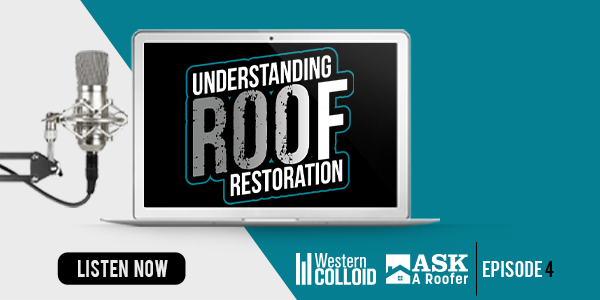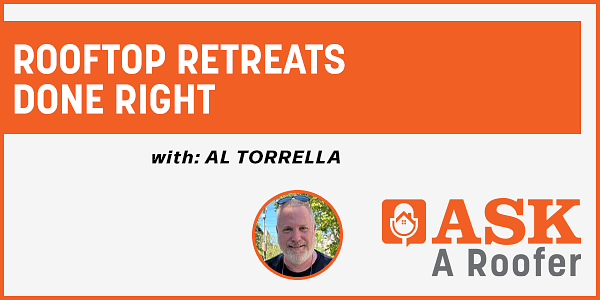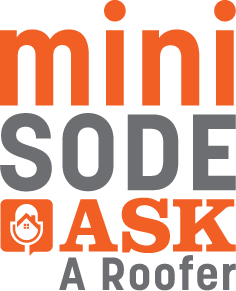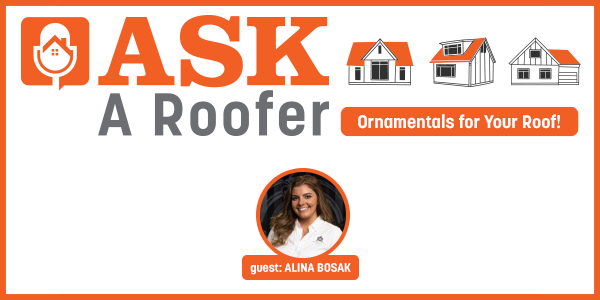Understanding Roof Restoration Episode 4 - Hail Damage and Fluid Applied Reinforced Roofing - PODCAST TRANSCRIPTION
February 22, 2023 at 6:00 a.m.Editor's note: The following is the transcript of a live interview with Greg Hlavaty and Hal Leland from Western Colloid. You can read the interview below, listen to the podcast or watch the webinar.
Karen Edwards: Hello, and welcome to The Understanding Roof Restoration Podcast. I'm your host, Karen Edwards, from askaroofer.com. The Understanding Roof Restoration Podcast dives deep into the topic of restoring roofs. As the popularity of roof restoration continues to grow, there are many questions that arise. With a wide variety of roofing systems on existing buildings and many available restoration options, we turn to the experts at Western Colloid to answer your questions on roof restoration. Greg Hlavaty, Hal Leland, and the team at Western Colloid have been manufacturing and installing these systems for more than 50 years, and they have seen it all. We will tackle a different topic each month and answer questions submitted by you, our listeners.
Hello, everyone. I am Karen Edwards with askaroofer.com. And we are here for another episode of Understanding Roof Restoration. And I would love to welcome Greg Hlavaty and Hal Leland from Western Colloid.
Hal Leland: Hello.
Karen Edwards: Hey, guys.
Greg Hlavaty: Good morning. Glad to be here. Thanks.
Karen Edwards: Yeah. So today, we're going to talk about understanding hail damage remediation using fluid applied reinforced roofing as kind of a remedy to prevent future hail damage. And I just want to talk a little bit about identifying whether you have hail damage on a commercial roof. It seems like a pretty tough thing to do.
Greg Hlavaty: You're right. It's not cut and dried. First of all, you have to know you've had hail. I mean, sometimes buildings are not occupied when they're ... It might be at night. It might be your warehouse building, whatever. You kind of want to know if there's been a hail event, they call it a hail event. And then it takes a really good roofer, and different types of roofs are tough to find out if there's really damage, especially immediately after the hail event because what happens is it might make little shatter cracks in that roof, depending what type of roof it is, that aren't very visible immediately because it's probably wet and clean and had rain also, along with the hail.
And until dirt starts to build up on it and fill those cracks in, sometimes you don't see it immediately. One of the ways some of the inspectors look at is they actually walk around to the sheet metal and see if there's dents in the sheet metal in the air conditioning, on the vents, and what have you. And if they see dents, then they know there's been hard enough impact of hail that the roof could be compromised. Then it takes really good specialist, a good contractor who's familiar with it because different types of roofs react in different ways.
Sometimes it's just a dimple on the surface of the roof, but on a built up roof with hot asphalt that is not very flexible and what have you, and even on some modified bitumens, the shattering of the membrane is underneath. You don't even see it. You just see a dimple on top and a shattered membrane underneath. So it does take some investigative work. It's just not a quick view. Single plies might be a little bit easier, but again, they don't show up right away maybe hail damage because there might be little spider cracks from that hail impact that are perfectly clean right after the hail impact, so you don't really see them unless you're way down on your hands and knees.
But a week later, when dirt has built up on the roof, just fine dirt, starts filling in those cracks, and all of a sudden, you see those little shatter impacts. So sometimes it takes a couple of inspections, so it's not an easy thing to find out if you have hail damage. Sometimes it is. Sometimes it's very blatant. There are large fissures and big ... If you've got a lot of insulation on your roof, the dimpling could be bigger, where it depresses the insulation underneath and you see like a golf ball has hit and left the partial impression on it. That's because that insulation has a deflection in it. And so you can see that there's been something impact. Then it's a matter of: What does that roof need to repair it?
Karen Edwards: So in some cases, someone might not even know that they've had damage from a hair storm until they start seeing signs of water intrusion or other issues inside the building.
Greg Hlavaty: Yep. In the residential side, I had a house in Texas that was rented out and had a roofer come by and say, "Hey, I think you got some hail damage on it." This was only a three or four year old roof. Excuse me. I thought I had that turned off. And when they went up and we pulled up some of the shingles, the backs of the shingles were shattered. The asphalt was actually shattered and breaking, but you didn't see very much on the granules on the surface, so he knew what he was talking about. And he looked at them, and they came out and they did replacement on that, the insurance and a roofing company. So it takes somebody who knows how to deal with hail sometimes to inspect and evaluate those kind of roofs.
Karen Edwards: So it's not always easy. Hal, did you have anything to add there?
Hal Leland: Yeah. Greg's completely right there. And most of my consultants, after they've been called on a hail event, they'll go out and they'll take cuts out of the roof. They'll remove either the built up or the single ply, and they'll take 12 inch by 12 inch squares out. And most of the damage, Greg is right, is on the back sides, on the underside. You can see the shattering where you can't really see it on the surface. But you had an event, the roof's leaking, and these guys are investigating. And that's normally what my guys will do in Northern California in the rim. They'll take pieces out and check the back. And it's clear as day when you see that.
Karen Edwards: Wow. Yeah. I mean, it's cold now, but storm season is right around the corner, so I think our discussion of hail damage is pretty timely. Do you see certain substrates that are more affected by hail, and some that are more resistant to hail?
Greg Hlavaty: Hal probably has a good handle on that. He does a lot of that, the testing at Factory Mutual for us, and the types of membranes that get affected.
Hal Leland: The built up roof, it's blown asphalt, so it's very brittle. It goes on hot, and so I mean that takes the most damage, a built up roof. Modified, like Greg said, are better because they're modified asphalt and they've got some polymers in there and it's a softer sheet. But built up takes the worst brunt of it. And single ply, nothing's free from hail damage, single ply membranes, they get beat up very, very bad, TPO more than PVC, but they all take the same damage.
Greg Hlavaty: And the underlayment has a lot to do with it too, the insulation, because if you've ever walked on a carpet with no padding, you get very little deflection. It's a solid piece. So if that hail impacts and there's a nice solid piece of plywood behind it, it can't deflect that roof too much. It can compress it, but it can't deflect it very much. But if you have some nice soft insulation, which our insulation laws throughout the country right now, most of these commercial roofs have a lot of insulation, that allows for some deflection, which means that membrane's taking a much bigger impact because it's being deflected and mis-shaped to a grater extent, so it has to take more impact.
So there's pros and cons to our insulation factors because hail impact wasn't as bad in years past when they were putting it right over new good half in plywood decks, even a built up roof. It was solid. It was hitting that roof, and it was like hitting your floor, boom. And so it caused a panic out there. But with the insulation and all the various types of membranes now, it's getting more and more evident of hail damage.
Hal Leland: So how to repair hail damage, and I know that's going to vary a lot based on the amount of damage, the type of roof. What should building owners and contractors know about addressing hail damage?
Greg Hlavaty: I tell you what, there's one step in this that we haven't talked about, and is important, and that's the insurance company that's going to be involved if there is insurance, and what they will allow you do to on a roof. That's become a problem in years past. It's getting a little bit better now. But historically, if you had hail damage, an insurance inspector would come out. They'd look at, they'd evaluate that roof. And if it had to be re-roofed, if it was very minor, they might ask for repair. But in most cases, they would do a replacement. If they do a replacement, for liability reasons is what the insurance companies claimed, they went back with the same roof that was on. So okay, we're replacing this, this had an X, Y, Z built up roof. We're going back with that same roof.
And I think they claim it was because of liability. If they put something else on now, they're on the hook for changing what was there. And now if something happens in the future, they don't want that liability, so they just go back. And that became very expensive because they were tearing off roofs, putting new roofs on, expensive roofs. And that was kind of the go to repair or replacement. And that is changing somewhat. There's a little bit more enlightenment in the industry because we've always asked the insurance inspectors and consultants that are involved with inspectors to consider one of our fluid applied membranes.
Again, in the past, because liability, they may not have wanted to, but they have recently started to do it because of the cost. And so they're evaluating it based on if they can get an equal warranty to what they had of the original, then they feel more comfortable with it. And there are some consultants, especially in the Texas and Midwest, lower Midwest region right now, we work with one or two there that are working actively in the insurance industry, working with the insurance companies saying, "Hey, you're spending way too much, millions too much on these re-roofs when there's an alternative that can give you a membrane that'll have equal or greater life with a warranty from a solid manufacturer, and not have to go back with the tear it all off, tear it down to the deck and put the same thing back on." And maybe the same thing back on isn't the latest technology, but they'll still going back to the same thing they did before.
So it isn't always a benefit to the owners at all. I'm getting a new roof. Yeah, you're getting a new old roof, something that was done years ago. So there's a little more enlightenment. It isn't spread everywhere, and we'd like if you're a contractor listening to this, that's something you want to talk to an insurance agent if you're involved or whatever because they can fight for you to go to their underwriters and say, "Look, we can put a membrane on here that has hail testing," as Hal will talk about here in a minute, and hail resistance, and is ... Even if there is a really bad event, it's easily repairable without replacing, so that's the first part of that.
And the second part is that you can go various levels, depending on how much life expectancy's left in that roof. Do you want to just get through? We had a roof on here that was expected to go 20 years, and we're 12 years into it, we need eight more. And we had a hail thing. So you can go economically with one of our fluid applied reinforced systems, a lighter weight one, to get them by those years, or maybe make what we think is the right move and step up and put maybe a beefier system back on, multi ply fluid applied system that will give them 20 plus years going on from where they're at. And use one that's been tested at FM for various size hail.
Karen Edwards: Yeah. We're making a lot of sense because if I got a roof on my building and it was damaged and couldn't withstand the hail, probably going to happen again. Why would I want the same thing that didn't work if I have an option to get something that's a little more robust, that can withstand that hail, and has been proven? And that's why we're talking about the fluid applied reinforced roofing. And Hal, if you could talk a little bit about the performance in hail that you've seen in the testing, I think that would be great.
Hal Leland: Yeah. Greg's right. So you've got a built up roof or a single ply roof up there, and it's got hail damage, so the option is to tear it off and send it to the landfill and put a new one on top and replacing it. But we can go right over the top of those existing membranes with several of our fluid applied systems. We're just using that single ply or that built up roof as a base sheet, basically. We keep it there. We clean it. We still address all the details. And our go to in Texas has been an all acrylic polyester reinforced system right over a built up, or a TPO, or a PVC membrane, these large tilt ups. Right? And it's very cost-effective. We've tested that to severe hail at FM Global. And that's the one and three-quarter inch steel ball at 18 feet. Then we do 1000 hours in the Weather-Ometer, and we test it again. Yeah, it's a very cost-effective way to solve that problem.
Karen Edwards: This podcast is brought to you by Ask a Roofer and Western Colloid fluid applied roofing. When you're looking for answers for your roof, what better place than askaroofer.com? If you're looking for answers on restoring your commercial, industrial, or low slope roof, look no further than Western Colloid. For over 50 years, they have been bringing old roofs new life. Together, we're helping contractors, building owners, property managers, architects, engineers, and consultants choose the best commercial roofing system. Find Wester Colloid today on askaroofer.com.
So I'm curious about warranties, warranty systems, and if a building owner has a roof that maybe still has a few years of its warranty left, but they're going to choose to use a Western Colloid solution to increase the ... Are they just getting a new warranty then from you?
Hal Leland: Yeah.
Greg Hlavaty: At that stage, it's going to become our roof, not the existing manufacturer's roof, which the existing manufacturer may be happy about to get out from under that. And there's a couple of steps. We have in certain regions where they do some ... Hail damage is not covered directly under our warranty. It's extreme acts of nature. But that roof can be repaired. And we also sometimes do hail, or what we call hail riders on our warranties. And some other companies do this also, and it's not exactly what you think. A hail rider doesn't just mean if there's a hail event, and there's damage, we just run out and fix it.
What that means is under normal warranties for most of the manufacturers, if there's a major hail event, that warranty may be voided. It's an extreme act of nature and that's the end of the warranty. Insurance steps in then. That's not warranty, it's insurance that takes care of it. You don't see the major manufacturers running out and replacing those roofs when there's hail damage. You see insurance companies doing that, and there's a reason for that, because the warranty's over at that point.
In our case, it's similar. We would be the same unless in certain regions we do this in Colorado and a few areas in Texas and what have you, where they get a hail rider. And what that does, that insures the insurability of that. What that means is if there's a hail event, there still has to be repairs made on that roof if it needs. You go up there and inspect it. It's made to withstand it, but it doesn't mean there can be spots that need to be repaired. And as long as those are repaired in a timely manner within a month or so of the event, or one or two months, then the original warranty stays in effect instead of, which was what most manufacturers do, is say, "Nope. It's over with." They'll take their warranty and tear it up. You had a hail event, it's gone. So there are ways to address that. It has to be done with a separate request, but it can be done because not everybody ... There are actually corridors where you can go to the different weather services, the national-
Hal Leland: The NOAA [inaudible 00:18:48].
Greg Hlavaty: The NOAA and that, and you can look and see where the hail events happened, what size the hail was. You can see the corridors where they moved through different, sometimes it's valleys. Up in the Rockies, you'll have certain areas in Colorado, not everywhere, but certain valleys where that hail moves through. And so you kind of know where you're going to be under duress for hail impact.
Hal Leland: Yeah. We have events in the Pacific Northwest, through Montana. Every five years it seems like we have hail come through on a regular basis. And we've got these hail chasers going up there and replacing entire neighborhoods' shingle roofs. So it's prevalent, it's something you have to take a look at.
Greg Hlavaty: You know that. You publicized some stuff at Roofer's Coffee Shop about the hail chasers or the storm chasers and that. Some of them are I'm sure quality roofers, and some of them, they take advantage of their people. So that's the other thing, is be cautious and don't just talk to one person. Talk to a couple of contractors. Talk to maybe a couple manufacturers. And be cautious if you've had a hail event because there are people that swoop in, make their cash, and get the heck out of town, so we want building owners to be careful [inaudible 00:20:20].
Hal Leland: Support your local contractors. Just pay attention. It's not difficult, but you have to be aware of it.
Greg Hlavaty: Getting back to, I'll tell you something that happened with us. Some years ago, Phoenix had a rather large hail event. I'm going to say six, seven years ago, it could've been eight. I can't even remember the dates. But it was very unusual, swept through there, did a lot of damage in town. And this is getting back to the insurance companies, where you want to kind of fight for what's right or what they can do best. When we saw that, and we knew there was a lot of damage, there was a lot of leaks reported, lot of damage reported. We said, "Boy, this is going to be a very good year for our company in that region. There's going to be people wanting." And it didn't even move the needle, and that's because of the insurance companies.
They would not put on a more economical, even if it's a stronger, better roof, they wouldn't step out of their comfort zone or their liability zone to put on a roof that might perform better. They just went right back, if it was foam, they took it off and sprayed foam on it. If it's built up, they tore it off, put a built up back on. If it was modified bitumen, they tore it off, put modified. Single ply, same thing. They just wouldn't take that next step to maybe upgrade that roof to something that's maybe a little tougher and a little better. So hopefully, that has changed. And we're seeing it change in some places, and we're seeing some consultants that are active out there, trying to work with insurance companies because you and I pay the insurance premiums based on this. It isn't just that building owner that's affected. It's all of us that are affected.
Karen Edwards: It seems like in areas that are more ... You just mentioned in Phoenix, it was extremely rare. So insurance companies were very hesitant to step outside their comfort zone. But in the areas like Texas, the hail belt, where it's becoming more prevalent, that's where it seems like, sounds to me like you're saying it's changing a little bit. They're kind of coming around to considering better systems.
Greg Hlavaty: Yep.
Karen Edwards: Wow.
Greg Hlavaty: And there's a few systems out there that Hal can speak to that go kind of overboard. We go up to extreme hail. But there's ... What do they call it, Hal?
Karen Edwards: Very severe.
Hal Leland: Very severe hail. They've got a new test and it's crazy. It's super violent and only a few manufacturers have built systems to meet it because it's crazy. We stopped at severe hail because that's the bulk of these events. One and three-quarter inch steel balls, it's a big deal. Right? And so we [inaudible 00:23:11].
Greg Hlavaty: That's a much bigger ice ball. Right, Hal? I mean, one and three-quarter inch steel ball is not like one and three-quarter inch hail because hail's lighter.
Hal Leland: Right. Oh, yeah. This would be like three inch hail. I mean, that's massive. Right?
Greg Hlavaty: And to pay all that money for that very severe hail when you can go right up to that doorstep of that without spending lots of extra money because one thing it will include is going to be a new deck, whether it's ... Remember the compression thing we talked about, about compressing that insulation and all that? Well, they want something really hard and really solid under whatever you're putting on there, so they're going to overlay that if it's an overlay, with a new deck, whether it's OSB, or another type of board-
Hal Leland: Or a board.
Greg Hlavaty: That will not allow the deflection of the membrane that they're putting up. Now that's really the secret. That's what they're doing. They're going back to a nice, solid plywood deck that years past held up okay. It's the insulation that's changed this. So if you want to spend the money for that, you can. But you can get everything up to that, and the thing about it is, ours, even with that very severe hail, if there is damage, it's repairable without re-roofing it. It's addressable, that's the nice thing about these systems.
Karen Edwards: That is key I think, yeah. Because if you can just make the repairs and not have to do an entire new roof, everybody wins, including the insurance company. Wow. Well, guys, this was really, really interesting. I just want to let everybody know that this podcast will be available on westerncolloid.com. It's also available on askaroofer.com or wherever you listen to your favorite podcasts, be that Spotify, Apple. We've got it out there on all the channels. And we encourage listeners to send us your questions. You can go to askaroofer.com. You can submit questions that we will discuss. If we do get your question and talk about it on the podcast, we'll send you a gift. Who doesn't like a free gift? And then next month, I invite you to tune in because we're going to be talking about a really interesting topic, which is reconditioning and restoring gravel roofs.
Greg Hlavaty: Oops.
Karen Edwards: Yeah, we'll be talking about that. And send us your questions. Thank you, all, for tuning in. And we'll talk to you again on the next episode.














Comments
Leave a Reply
Have an account? Login to leave a comment!
Sign In